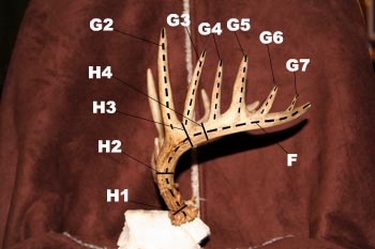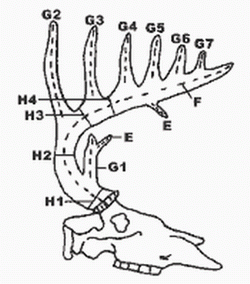What’s a G2, G3, etc.?
The majority of hunters know that the Boone & Crockett Club measuring system is the most common way to score white-tailed deer antlers, but many don’t know how to properly score a harvested buck. Of course, hunters also score shed antlers or dead bucks they have found somewhere.
In order to correctly score a buck you first need to understand how to take the required antler measurements, and that calls for the clarification of some B&C terminology. It’s relatively simple once you learn the lingo, but not something that’s easy to recall unless you score deer on a regular basis.
Learning the proper terms will help tremendously when discussing antlers in general and specific measurements with another hunter that is experienced with scoring deer antlers. Otherwise, one will not understand they other and that just means at least one of you will be completely lost — kind of like going anywhere without knowing the native language. Knowing what terms refer to will not only help you “get it,” but lend you and others confidence that you know what you’re doing.

Boone and Crockett Terms
Point – To be a point the projection must be at least one inch long, with the length exceeding width at one inch or more of length. All points measured from tip of point to nearest edge of beam. The beam tip is also counted as a point, but it is not measured as a “point” since its length is included in total beam length.
Abnormal Point – Abnormal points are those non-typical in their location, such as points originating from a normal point, the bottom or sides of the main beam, or extra points beyond the normal pattern of points. For an example of an abnormal point, look at item E in the photo below. There are two examples.

Burr – The end of a buck’s antler that flattens out at the at the base of the head.
Beam Length – The measurement from the bottom of the burr to the tip of main beam. Item F in the photo is an example of the main beam measurement.
Gs – The letter G is used to name normal antler points. G1 refers to the first point on an antler. This is typically the location of the brow tine (if the brow tine is missing, the G1 is missing). G2 is the next tine, then G3, and so on (see photo above). A normal 8-point buck would have a G1, G2, and G3. A normal 10-point buck would have a G1, G2, G3 and G4. The end of the main beam IS NOT referred to as a G, although it does count as a point.
Hs – The letter H is used to refer to circumference of a buck’s antler. H1, H2, H3, and H4 refer to the locations on an antler where circumference, or mass, measurements are taken. Regardless of the number of points, only 4 H (circumference) measurements are taken on any buck. Circumferences are taken at the narrowest place as in the photo above. In the example above, the H1 measurement for a buck’s right antler would be the smallest circumference between the burr and G1. The H2 measurement would be the smallest circumference between the G1 and G2.
Eighths – You’ve probably noticed that deer scored using the B&C method have scores such as 134 5/8 or 176 2/8. Keep in mind that all measurements are taken to the nearest eighth inch. Record 1/2 inch as 4/8 inch and it will make the math easier, especially if you don’t have a calculator!











